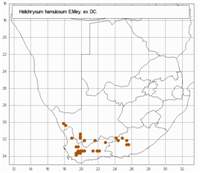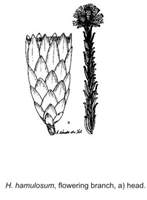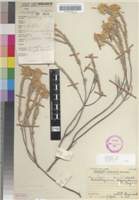Common names:
Geel bergsewejaartjie (A)
Origin of name:
hamulosus = armed with small hooks
Diagnostic characters:
Linear, needle-like leaves white-hairy below, glabrous-glandular aboveLeaf tips hookedMedium-sized heads in sparse or dense corymbsStraw-coloured bracts
Description:
Well-branched ericoid shrublet up to 600 mm tall, old branches nude, rough with old leaf bases, branchlets white-tomentose, closely leafy. Leaves suberect, imbricate, 6-25 x 1 mm, linear, apex acute, mucronate, hooked, base broad, sessile, margins strongly revolute, upper surface glabrous or with a few woolly hairs, lower white-tomentose. Heads homogamous, cylindric, c. 6-7 x 2 mm, many in dense terminal corymbose panicles. Involucral bracts in 5-6 series, graded, imbricate, a little shorter than the flowers, ovate-lanceolate, acute or subacute, straw-coloured, glossy, erect. Receptacle with fimbrils up to half as long as ovaries. Flowers 5-14. Achenes 1 mm long, with myxogenic duplex hairs. Pappus bristles many, nearly equaling corolla, scabrid, bases nude, not cohering.
Flowering from December to March.
Distribution:
Widespread in the dry interior of the Cape, from Kamiesberg. Calvinia, Wuppertal and Worcester degree squares east through the Great and Little Karoo to Hanover, Graaff-Reinet and Oudtshoorn. A constituent of shrub communities.
Fynbos, Succulent Karoo, Nama Karoo and Grassland Biomes.
Taxonomy:
Literature:
Helichrysum hamulosum [E. Mey. ex] DC., Prodr. 6: 192 (1838); Harv. in F.C. 3: 249 (1865); Moeser in Bot. Jb. 44: 251 (1910).
Type:
South Africa, Dr�ge 932 (G-DC, holo.).
Synonym(s):
Vouchers:
Acocks 18619 (PRE); Bolus 1052 (BM; BOL; NBG; NU); Compton 12907 (NBG); Hilliard & Burtt 10718 (E; K; MO; NU; PRE; S); Schlechter 9908 (BM; BOL; E).


_sml.jpg)
_sml.jpg)
